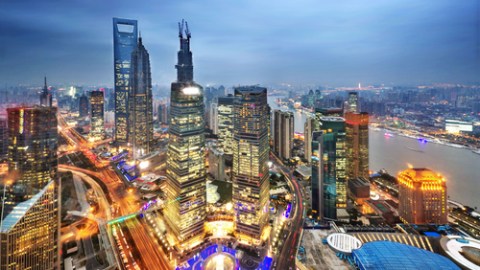Rebooting China

MILAN – Despite China’s widely discussed economic slowdown, annual GDP growth remains above 7%, implying little cause for alarm – at least for now. The question is whether the government’s efforts to implement structural reforms and transform the economy’s growth model are working – that is, whether internal imbalances continue to threaten long-term economic performance. Given that China remains the global economy’s most important growth engine, the answer matters to everyone.
Assessing China’s economic stability requires considering the conflicts and tensions affecting the country – none of which advances the cause of growth. For starters, China’s territorial disputes with many of its neighbors, including Japan, Vietnam, and the Philippines, are undermining regional peace, not to mention economic integration.
Moreover, China’s relationship with the United States is deteriorating, owing to conflict over America’s foreign-policy “pivot” toward Asia and disputes over cyber security. China has already restricted access to its market for some US-based technology firms, and more such actions may follow.
Meanwhile, China’s domestic political system is being shaken up by President Xi Jinping’s anti-corruption campaign – an effort that is essential to boosting the government’s accountability and legitimacy as it pursues deep systemic reforms. But, at a time of rising international tension, there is a risk that Xi’s campaign could mutate into a broader assault on political dissent attributed to “corrupt” foreign influences.
Since China launched its process of “reform and opening up” more than three decades ago, it has benefited from its willingness to consider – if not adapt – foreign ideas. In many areas – economic policy in a market economy, business management, technology, energy, the environment, and health care, to name a few – selective learning has accelerated China’s development (and benefited the countries that have learned from Chinese experience). Lumping outside influences together with a legitimate anti-corruption campaign would undermine this positive dynamic, with potentially serious consequences for China’s quest to transform its growth model and achieve high-income status.
The good news is that the data – while incomplete – show progress in China’s economic transformation. Weak growth in China’s major export markets (particularly in Europe, North America, and Japan), together with rapidly rising domestic wages and incomes, is driving the tradable part of the economy toward higher-value components in global supply chains. Meanwhile, inflation, rising wages, and the renminbi’s nominal appreciation have driven up the real effective exchange rate, though this trend has been tempered, to some extent, by the euro’s persistently high value. How businesses handle this transition – which is already contributing to China’s growth slowdown – will determine the transformation’s progress.
China has no choice but to change its growth model. Its share in global markets is now so large that the economy could be demand-constrained for the first time in four decades. The only way to avoid this outcome is by pursuing a balanced program comprising high-return investment, high-value government services, and a higher level of household consumption.
Public and private investment – which has served as a key driver of China’s growth over the last four decades – can play a central role in expanding domestic demand, but only if returns are high. While low-return investments generate aggregate demand, they do not increase future income or productive potential, and thus do not foster sustainable growth.
Given this, China’s leaders must use a combination of financial-sector reforms and improved public-sector incentives to increase access to capital in sectors with high potential rates of return. In fact, this process is underway with the licensing of new private banks and the development of China’s shadow banking system.
Given the limited capacity of investment demand to drive growth, high-value government services and increased household consumption are also needed. As it stands, private consumption accounts for an unusually small share of China’s GDP. But rising wages – partly the result of mandated minimum-wage increases in some regions – are boosting household incomes, and there is already some evidence that the downward trend in consumption’s share of GDP has reversed.
Consider the telecommunications-equipment industry, which has been growing at more than 15% annually in the past couple of years. Gross merchandise volume in online retail sales is approaching CN¥2 trillion ($316 billion), and growing at a rate of 40-60% annually. Many other industry segments serving domestic demand are also growing at double-digit rates, suggesting that domestic consumption is already making a more significant contribution to China’s GDP growth.
But there remains the question of whether consumption share growth is sustainable – that is, whether it is the result of income share growth or rising leverage. If it is supported by excessive leverage, effectively shifting future consumption to the present, China could face a significant slowdown – or even a major crisis.
Leverage has undoubtedly increased at unsustainable rates in recent years. But, given that debt growth began from a low base, it will not necessarily lead to a crisis – as long as appropriate risk management is in place. Most important, shadow banks’ activities must be regulated in a way that enhances transparency and deters excessive risk-taking, while allowing the sector to continue to contribute to financial-sector development by providing savings options to households and credit to small and medium-size firms.
As for the official banking sector, liberalization of interest rates on deposits, scheduled for 2016, will reduce financial repression and implicit investment subsidies. That, in turn, should help to rebalance the demand side of the growth pattern.
Such complex structural changes cannot be perfectly synchronized and thus are likely to be accompanied by a dip in growth rates. The government has expressed a willingness to accept somewhat slower growth in pursuit of a more stable, sustainable economy. But whether a slowdown is the start of a trend or a temporary part of a complex transition, will not be apparent from the start. Ensuring that it is the latter will require the patience and discipline – in both domestic and foreign policy – befitting the major transformation now underway.
Michael Spence, a Nobel laureate in economics, is Professor of Economics at New York University’s Stern School of Business and Senior Fellow at the Hoover Institution. His latest book is The Next Convergence – The Future of Economic Growth in a Multispeed World.
Copyright: Project Syndicate, 2014.
www.project-syndicate.org





